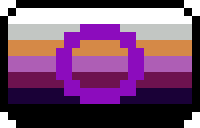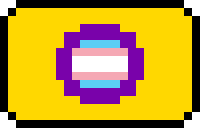
Intersex

Table of Contents
- Introduction
- General Information
- Intersex Variations
- 5-Alpha Reductase Deficiency (5-ARD)
- 17-beta Hydroxysteroid Dehydrogenase 3 Deficiency (17 beta or 17-beta HSD)
- Androgen Insensitivity Syndrome/AIS
- Complete Androgen Insensitivity Syndrome/CAIS
- Partial Androgen Insensitivity Syndrome/PAIS
- Mild Androgen Insensitivity Syndrome/MAIS
- Anorchia
- Aphallia/Penile Agenesis
- Aromatase Deficiency
- Aromatase Excess Syndrome/Hyperestrogenism/AEXS
- Bladder Exstrophy
- Chimerism
- Cloacal Exstrophy
- Congenital Adrenal Hyperplasia/CAH
- Congenital Chordee
- De la Chapelle Syndrome/XX Male Syndrome
- Estrogen Insensitivity Syndrome/EIS
- Follicle-Stimulating Hormone (FSH) Insensitivity
- Fraser Syndrome
- Gonadal Dysgenesis
- Hyperandrogenism
- Hypogonadism
- Isolated 17,20-Lyase Deficiency/ILD
- Jacobs Syndrome/47XYY/XYY Syndrome
- Kallmann Syndrome
- Klinefelter Syndrome
- Luteinizing hormone insensitivity
- Mayer-Rokitansky-Küster-Hauser Syndrome/MRKH/Müllerian Agenesis
- Mosaicism
- Müllerian Duct Anomalies
- Ovotesticular DSD/Ovotestes
- Penoscrotal Transposition
- Persistent Müllerian Duct Syndrome/PMDS
- Progestin-Induced Virilization
- Polycystic Ovary Syndrome/PCOS
- Swyer Syndrome/Complete Gonadal Dysgenesis
- Trisomy X/Triple XXX Syndrome
- Turner Syndrome/XO Syndrome
- Vaginal Atresia
- XXYY Syndrome
- Intersex Pride Flags
- Intersex Pride Flag
- Close to Androgynous Flag
- Close to Female Flag
- Close to Male Flag
- Close to Neutral Flag
- Ipsogender/Ipso Flag
- Transgender-Intersex/Trans-Intersex Flag
- Ultergender/Ulter Flag
- Glossary
- External Links
- 5-Alpha Reductase Deficiency Resources
- 17 Beta Reductase Deficiency Resources
- Androgen Insensitivity Syndrome Resources
- Aphallia Resources
- Aromatase Excess Syndrome Resources
- Bladder Exstrophy Resources
- Chimerism Resources
- Cloacal Exstrophy Resources
- Congenital Adrenal Hyperplasia Resources
- Congenital Chordee Resources
- De la Chapelle Syndrome Resources
- Follicle-Stimulating Hormone (FSH) Insensitivity Resources
- Gonadal Dysgenesis Resources
- Hyperandrogenism Resources
- Isolated 17,20-Lyase Deficiency Resources
- Jacobs Syndrome Resources
- Kallmann Syndrome Resources
- Klinefelter Syndrome Resources
- Lutenizing Hormone Insensitivity Resources
- MRKH Resources
- Mosaicism Resources
- Müllerian Duct Anomalies Resources
- Ovotestes Resources
- Penoscrotal Transposition Resources
- Persistent Müllerian Duct Syndrome Resources
- Progestin-Induced Virilization Resources
- Trisomy X Resources
- Turner Syndrome Resources
- Vaginal Atresia Resources
- XXYY Syndrome Resources
- Intersex Organizations
- Books/Journals/Studies/etc
- Additional Resources

Introduction
While intersex people are not inherently considered to be transgender, many do identify as being transgender. It is not uncommon for intersex people to have complex relationships regarding gender. What an intersex person will identify with or as varies from person to person, though people who are intersex are more likely to identify noncisgender or nonheterosexual than those who are not intersex. On a similar note, intersex people are not inherently considered to be nonbinary, though some intersex people will identify as such. This will vary from person to person, as everyone has their own unique experiences.
Before we continue, no, intersex people and animals are not "biologically nonbinary." Biological intersex variations ≠ human nonbinary gender identity. No, you cannot transition to become intersex (the words you may be looking for could be "altersex" or "salmacian"). See the relevant intersexism page for more information on the struggles of intersex people. Good allies don't use slurs. As always, for more information on topics or terms that you may not be familiar with, click on underlined words or use the alphabet menu at the top of this page.

General Information
Intersex is an umbrella term referring to people who are born with variations of sex traits such as chromosomes, genitalia, and/or hormones. Some intersex variations are obvious at birth. Others become known later in life; such as during puberty or adulthood. These variations fall out of the range of what is typically considered "male" or "female." It is estimated that 1.7% of the population has an intersex trait, with 0.5% having clinically identifiable reproductive or sexual variations.

Intersex Variations
Please note that all intersex variations are conditions that one is born with. You cannot transition to become intersex. Most of these conditions exist on a spectrum, and no two people with the same disorder present exactly the same.

5-Alpha-Reductase Deficiency/5-ARD/Pseudovaginal Perineoscrotal Hypospadias/PPSH/Steroid 5-Alpha-Reductase Deficiency
5-ARD is an intersex variation that affects sexual development before birth and during puberty. Those who have this variation have XY chromosomes. Most people with 5-ARD have testes and produce typical levels of testosterone. Some will have a micropenis that may have proximal hypospadias. Some will have a vulva and be assigned female (possibly without being identified as intersex). Some people will be born with ambiguous genitalia. Most people with this intersex variation are infertile.
Someone with this disorder does not have the enzyme responsible for converting testosterone into the more powerful anti-androgen known as dihydrotestosterone (DHT). During puberty, someone with 5-ARD will typically develop some features assiciated with a typical testosterone-based puberty, such as increased muscle mass, depth of voice, hair growth, and possible genital growth.
This is a rare, genetically inherited condition.
Click to jump to external resources regarding 5-Alpha Reductase Deficiency.
Click to jump to corresponding intersexism page regarding 5-Alpha Reductase Deficiency.

17-beta Hydroxysteroid Dehydrogenase 3 Deficiency/17 beta/17-beta HSD
People with this intersex variation have XY chromosomes and testes. They do not have one of the enzymes needed to synthesize testosterone. Most people with this variation have a vagina, vulva, and undecended testes. Some have ambiguous genitalia. Some have a micropenis that may have proximal hypospadias.
During puberty, people with 17 beta will often develop secondary sex characteristics associated with a typical testosterone puberty.
Click to jump to external resources regarding 17 Beta.

Androgen Insensitivity Syndrome/AIS/Goldberg-Maxwell Syndrome
Those who have AIS have testes and XY chromosomes. The bodies of people with AIS have varying levels of insensitivity to androgens. This means that their cells do not respond typically to the testosterone being produced.
Click to jump to external resources regarding AIS.

Complete Androgen Insensitivity Syndrome/CAIS
Someone with CAIS is born with a clitoris, vulva, undecended testes, and usually has a vagina that is shorter than what is considered typical. They will not menustrate, due to a lack of ovaries and a lack of a uterus. People with CAIS have no response to androgens, and develop features consitent with an estrogen-based puberty. They will also experience gynecomastia. The body will naturally convert testosterone into estrogen through a process called aromatization.

Partial Androgen Insensitivity Syndrome/PAIS/Reifenstein Syndrome
Someone with PAIS will have less of a response to testosterone than someone who has XY chromosomes and no androgen insensitivity. Someone with PAIS will have more of a response to testosterone than someone with CAIS. They may have partially decended or undecended testicles. They may have genital differences such as a phallus that may be perceived as clitoromegaly or a micropenis, and/or a vagina that may be shallower than typical. They may have variations affecting the urethra such as a common urogenital sinus or hypospadias.
Someone who has PAIS may have genitalia that looks more like a vulva & vagina or more like a penis. Someone with PAIS may go through puberty and develop traits typically associated with both an estrogen-based puberty and that of a testosterone-based puberty.

Mild Androgen Insensitivity Syndrome/MAIS
Someone who has mild androgen insensitivity syndrome responds to testosterone less than what is typical for someone born with XY chromosomes, but more than someone with other variations of androgen insensitivity syndrome. Someone who has MAIS may have a micropenis, and will develop secondary sex characteristics associated with a typical testosterone-based puberty. As the body of someone with MAIS will convert a small amount of naturally produced androgens into estrogen, there may be visible variations regarding the amount of muscle tone, body hair, and/or facial hair developed during puberty. There is also a potential for gynecomastia during puberty.

Anorchia
An individual with anorchia is born without testes and with 46 XY chromosomes. People with Anorchia do not produce typical levels of testosterone. Usually, the body of someone with anorchia will have a typical-appearing penis and scrotum; as those organs are already formed by the stage of fetal development when the testes disappear.

Aphallia/Penile Agenesis
Someone with aphallia has testes, XY chromosomes, and is born without a penis. People who have aphallia will produce typical levels of testosterone during adolescence and will develop the secondary sex characteristics associated with a typcial testosterone-based puberty.
Click to jump to external resources regarding aphallia.

Aromatase Deficiency
A person who has an aromatase deficiency does not have aromatase, the enzyme responsible for aromatization. At birth, someone with XX chromosomes and aromatase deficiency may have a partially or completely fused labia (resembling the appearance of a scrotum) and experience clitoromelagy. Typically, most of the androgens that are produced by people with XX chromosomes are routinely aromatized into estrogen, but the androgens produced by somoene who has both XX chromosomes and an aromatase deficiency will influence the development of their external sex characteristics. During puberty, they may not begin menstruating, may not develop breasts, and may develop some secondary sex characteristics associated with a typical testosterone-based puberty (such as facial hair and muscle mass). Someone with aromatase deficiency may develop multiple cysts on their ovaries.
Someone with XY chromosomes can also have aromatase deficiency, but in this case it does not typically cause variations in their sex characteristics. However, someone with XY chromosomes and an aromatase deficiency may grow taller than typically, as estrogen is the hormone that is usually responsible for closing the bone growth plates.

Aromatase Excess Syndrome/Hyperestrogenism/AEXS/AES
Someone with aromatase excess has an increased production of aromatase, the enzyme responsible for aromatization. This generally due to mutations of the CYP19A1 gene. Aromatase excess is a genetic condition. Fertility is typically normal.
The body of somoene with XY chromosomes and aromatase excess will therefore have more active estrogen than the body of a person with XY chromosomes and typical levels of aromatase. As estrogen is responsible for the closing of the bones' growth plates, someone with aromatase excess syndrome will often stop growing at a shorter height. They may experience gynecomastia in adolescence, along with features associated with a typical testosterone-based puberty. Hyperestrogenism was formerly referred to as "familia gynecomastia" due to the development of breasts in those with XY chromosomes being one of the most recognizable effects. They will typically have two testes, and have both external and internal genitalia that is typical for those who were AMAB. However, it is possible for a person with XY chromosomes and aromatase excess to have mild hypospadias and/or a micropenis.
The body of someone with both an aromatase excess and XX chromosomes does not typically have sex characteristics that vary dramatically from that of someone without aromatase excess going through a typical estrogen-based puberty. That being said, someone with XX chromosomes and aromatase excess may experience breast enlargment, a short stature, and potential menstrual irregularities. It may result in agenital-like variations such as vaginal septums, vaginal hyperplasia (abnormal growth of the vaginal lining), or variations of the hymen.
Click to jump to external resources regarding Aromatase Excess Syndrome.

Bladder Exstrophy
Someone with bladder exstrophy is born with their urinary bladder exposed; either through an open abdominal wall, or outside of the body. Someone with bladder exstrophy usually also has an open pelvis, resulting from the pubic bones not joining together. This can cause genital differences.
The body of someone with bladder exstrophy and XY chromosomes often has a micropenis with epispadias and undecended testes.
The body of someone with bladder exstrophy and XX chromosomes often has a widly spaced labia (due to the wide spacing of the pubic bones), and epispadias.
Click to jump to external resources regarding Bladder Exstrophy.

Chimerism
Someone with two or more different sets of DNA is known as a chimera. Many people with chimerism and XX/XY chromosomes have both ovarian and testicular tissue, while others have only testes or only ovaries. Others still have gonadal dysgenesis. Some have noticable genital differences while others do not.
Someone can be born with chimerism when multiple zygotes combine and develop into one fetus (this can occur in the case of fraternal twins).
"Sex-chromosme discordant chimerism" is when at least one embryo with XY chromosomes fuses with at least one embryo with XX chromosomes. A person who develops in this way would have sets of both XX and XY chromosomes, for a chromosome pattern of 46XX/46XY, and could have a wide variety of different possible sex characteristics.
Click to jump to corresponding external links regarding Chimerism.

Cloacal Exstrophy
The body of someone with cloacal exstrophy has an open abdominal wall exposing their bladder, colon, and sometimes other abdominal organs. These organs may also be positioned outside of the body at birth. The anal opening may be blocked or may not have formed. The bladder is often split in two halves, and the colon and bladder may be connected. The pubic bones do not join together and, similar to bladder exstrophy, results in an open pelvis with noticable gential differences.
The body of someone with cloacal exstrophy and XY chromosomes may have undescended testes and a micropenis that is flat or split in two halves. They may also experience epispadias.
The body of someone with clocal exstrophy and XX chromosomes usually has epispadias, and may have septate hymen.
Click to jump to corresponding external links regarding Cloacal Exstrophy.

Congenital Adrenal Hyperplasia/CAH
A person with CAH can be born with XX or XY chromosomes. CAH refers to a group of difrferent but related genetic variations that affect the enzymes that allow the adrenal glands to make specific hormones that help regulate the body's functions. Somoene with CAH does not consistently produce the needed amounts of aldosterone (which regulars levels of potassium and sodium), cortisol (which regulates the response to stress or sickness), or both. This may result in naturally producing higher-than-typical levels of androgens, such as testosterone, to help the body compensate.
The body of someone with XY chromosomes and 17-ohp CAH is not usually considered to have a variation in sex characteristics, since an increased amount of androgens will not cause the development of any characteristics that are not considered typical for people assigned male at birth. That being said, there are some variants that can result in ambiguous traits in the genitalia. These are rarer variants of CAH.
The body of someone with CAH and XX chromosomes may have genital differences that may be noticed at birth caused by this increased androgen production. These differences may include clitoromegaly, urogenital sinus, and a fused labia. They may also develop certain characteristics during childhood or puberty such as body hair, increased muscle mass, and facial hair.
Click to jump to corresponding external links regarding Congenital Adrenal Hyperplasia.

Classic Congenital Adrenal Hyperplasia
Classic CAH is more likely to be noticed at or shortly after birth as the lower levels of cortisol and/or aldosterone production are more pronounced.

Salt-Wasting Congenital Adrenal Hyperplasia
This is a subtype of classic CAH that cuases "salt-wasting." "Salt-wasting" is a dangerous scenario in which the low levels of aldosterone cause a person's body to lose too much sodium. A person with the salt-wasting form of CAH can experience life-threatening adrenal crises, particularly when the body is under stress; such as when undergoing a surgical procedure or due to illness or infection.

Non-Classic Congenital Adrenal Hyperplasia/Late-Onset CAH
This variation of Congenital Adrenal Hyperplasia does not become apparent in people until later in childhood, adolescence, or even young adulthood.

Congenital Chordee
Chordee refers to a bend in the penis. A person that is born with chordee has a penis that curves downward, upward, or bends to one side. This is usually caused by bands of fibrous tissue that pull the penis in one direction. Someone with congenital chordee often also has hypospadias.
Click to jump to corresponding external links regarding Congenital Chordee.

De la Chapelle Syndrome/XX Male Syndrome
Someone who has this intersex variation is born with XX chromosomes in addition to a penis and testes. This occurs when a particular gene known as the SRY gene (typically found on Y chromosomes) ends up on one of the X chromosomes and caused the genitals and internal reproductive organs to develop as they typically would in someone with XY chromosomes. The testes of someone with De la Chapelle syndrome may be smaller than typical, undescended, and often infertile. In adolescence, someone with this intersex variation may experience breast growth, and might not develop the characteristics that are usually associated with a typical testosterone-based puberty.
Click to jump to corresponding external links regarding De la Chapelle Syndrome.

Estrogen Insensitivity Syndrome/EIS
The body of someone with estrogen insensitivity syndrome does not respond to estrogen.
The body of someone with EIS and XX chromosomes is usually born with a vulva and vagina. They may have a small uterus, and enlarged ovaries that later develop multiple cysts. They may produce very high levels of estrogen that their bodies do not recognize. They may not experience the changes that are associated with a typical estrogen-based puberty; such as breast development or menstruation. They may develop pubic hair and acne due to the influence of androgens.
The body of someone with EIS and XY chromosomes may or may not experience variations in their other hormone production, testicular development, and development of secondary sex characteristics.

Follicle-Stimulating Hormone (FSH) Insensitivity
The body of someone with FSH insensitivity does not respond to FSH.
Someone with FSH insensitivity and XX chromosomes is usually born with a vagina, vulva, and ovaries. The ovaries may produce lower amounts of estrogen than what is typical, and may not produce fertile eggs. They may not develop secondary sex characteristics associated with a typical estrogen-based puberty and may not menstruate.
Someone with XY chromosomes and FSH insensitivity may develop smaller than typical testes, may produce fewer sperm than usual, and may not be fertile.

Fraser Syndrome
Someone with Fraser Syndrome is usually born with differences in the development of their fingers, toes, and eyelids. They can also have variations in their sex characteristics, such as clitoromegaly or cryptorchidism. They may also develop without one or both kidneys and other parts of the urinary system can additionally be affected.

Gonadal Dysgenesis
This is a group of different variations that affect the development of the gonads before birth.
Click to jump to corresponding external links regarding Gonadal Dysgenesis.

Complete Gonadal Dysgenesis/Pure Gonadal Dysgenesis/Swyer Syndrome
The body of a preson with complete gonadal dysgensis has either XX or XY chromosomes and fiberous gonadal tissue that has not developed into testicles or ovaries (known as streak gonads). A person with complete gonadal dysgensis is generally born with a vulva and a vagina. They will usually not develop secondary sex characteristics at puberty, as streak gonads do not produce hormones.
Swyer syndrome occurs when someone is born with XY chromosomes, but their gonads have not developed into testes. Since the streak gonads do not produce testosterone, the body does not develop a penis, and instead usually develops a vagina and vulva. As they do not produce another hormone known as anti-Müllerian hormone (AMH), they often develop a uterus and fallopian tubes as well. People with Swyer Syndrome usually do not start puberty nor menstruate, though with estrogen therapy, they will menstruate without ovulation.

Partial Gonadal Dysgenesis/PGD
A person with PGD inherently has 46/XY without mosaicism. and may develop some testicular tissue and some gonadal streak tissue. They may be born with a penis, a vulva, or with visible genital variations. They usually have a partially or completely developed uterus, and may have combinations of internal reproductive structures, such as a vas deferens and a fallopian tube on opposite sides of the body. They may develop some secondary sex characteristics associated with a typical testosterone-based puberty, depending on the amount of hormone-producing testicular tissue present.

Mixed Gonadal Dysgenesis/MGD
Someone with mgd inherently has some layout of XO/XY (or XX/XY, XO/XXY, XX/XXY, etc) and may develop some testicular tissue and some gonadal streak tissue. They may be born with a penis, a vulva, or with visible genital variations. They usually have a partially or completely developed uterus, and may have combinations of internal reproductive structures, such as a vas deferens and a fallopian tube on opposite sides of the body. They may develop some secondary sex characteristics associated with a typical testosterone-based puberty, depending on the amount of hormone-producing testicular tissue present.

Hyperandrogenism
Someone with hyperandrogenism has higher-than-typical levels of testosterone and/or other androgens. In people with XX chromosomes, this can result in the development of secondary sex characteristics that are associated with the influence of testosterone (such as facial and body hair) to varying degrees. Hyperandrogenism may or may not be the result of an intersex variation, though it is common for those with variations such as CAH and PCOS. People with hyperandrogenism that are not intersex will often have may experiences in common with intersex people, such as encountering exclusion and discrminination in contexts where participants are separated by sex; such as in sports.

Hyperandrogenism pride flag.
Click to jump to corresponding external links regarding Hyperandrogenism.

Hypogonadism
The body of a person with hypogonadism produces lower-than typical levels of testosterone and estrogen, or sometimes none at all. This can effect the development of their secondary sex characteristics, and can also affect fertility. Hypogonadism can result in a difference in how someone's brain signals the gonads to produce (or not produce) hormones or it can be a feature of their gonads directly. Hypogonadism is not always caused by an intersex variation, but it can be related to Turner Syndrome, Klinefelter Syndrome, or several other variations.

Isolated 17,20-lyase deficiency/ILD
Someone with ILD has one of several specific variations in their genes that cause their bodies to make lower-than-typcial amounts of testosterone. They may be born with genitals that do not appear quite like a typical penis, and their testes may be descended or undescended. Someone with ILD may not experience all of the changes related to a typical testosterone-based puberty, due to how this intersex variation impacts hormone production.
Click to jump to corresponding external links regarding Isolated 17,20-lyase deficiency/ILD.

Jacobs Syndrome/47XYY/XYY Syndrome
Someone with Jacobs Syndrome might not have any obvious physical variations as a result, but they may be taller than usual or have other identifiable differences that do not relate to sex characteristics. They may also have hypospadias, a micropenis or a smaller-than-typical scrotum, and/or undescended testicles.
Click to jump to corresponding external links regarding Jacobs Syndrome.

Kallmann Syndrome
Kallmann Syndrome is a form of hypogonadism. Most people with this intersex variation will start puberty later than usual. Kallmann Syndrome may also affect someone's sense of smell.
The body of someone with Kallmann Syndrome and XY chromosomes typically has a micropenis and cryptorchidism. They may not experience typical pubertal changes, such as developing facial hair or a deeper voice.
The body of someone with Kallmann Syndrome and XX chromosomes may not experience typical pubertal changes such as developing breasts and starting to menstruate.
Click to jump to corresponding external links regarding Kallmann Syndrome.

Klinefelter Syndrome
Someone with Klinefelter Syndrome develops an extra copy of the X chromosome, resulting in a 47XXY pattern (as opposed to the typical 46XY). These individuals may have smaller-than-typical testes that produce lower amounts of testosterone and/or sperm. They may start puberty later than typical, or be unable to go through puberty without hormone therapy. They may develop breast tissue, may grow tall, and often experience infertility. This intersex variation often does not cause obvious physical differences, resulting in many people not realizing that they have it.
Click to jump to corresponding external links regarding Klinefelter Syndrome.

Luteinizing hormone insensitivity
The body of someone with XY chromosomes and luteinizing hormone insensitivity develops a variation of LCH (as discussed above).
As someone with XX chromosomes does not typically produce Leydig cells to begin with, someone who has XX chromosomes and this insensitivity will be affected in a different way (compared to someone with XY chromosomes). Someone with XX chromosomes and this intersex variation does not usually have any noticable differences at birth, but may not menstruate, and their ovaries may not produce fertile eggs.
Click to jump to corresponding external links regarding Luteinizing hormone insensitivity.

Leydig Cell Hypoplasia/LCH
The body of someone with Leydig Cell Hypoplasia (LCH) has XY chromosomes and a genetic insensitivity to Luteinizing Hormone. Luteinizing Hormone is typically responsible for the development of Leydig cells in the testicles, and then signaling those cells to produce androgens such as testosterone. Someone with LCH will develop no or few Leydig cells, and will therefore produce less testosterone than typical.

Type 1 LCH/Complete LCH
Someone with Type 1 LCH produces almost no testosterone and will usually be born with undescended testes, a vulva, and a vagina. They are usually assigned female at birth. This intersex variation is often not recognized until adolescence, at which point they generally will not develop any secondary sex characteristics or experience other changes typically associated with puberty.

Type 2 LCH/Partial LCH
Someone with Type 2 LCH has some response to Luteinizing Hormone, and produces more testosterone than someone with Type 1 LCH, but less than typical. At birth, their testes may be descended or undescended. They may have a micropenis, and often have other noticable differences, such as hypospadias. In adolescence, they often develop some characteristics associated with a typical testosterone-based puberty.

Mayer-Rokitansky-Küster-Hauser Syndrome/MRKH/Müllerian Agenesis
MRKH results when someone's Müllerian ducts (which typically become the uterus & upper portion of the vagina during fetal development) do not develop in the typical way. People with MRKH have XX chromosomes. They are usually born with a vulva and either no vagina, or a vagina that is shorter that is typical. They may have a partial uterus (uterine remnant) or no uterus. They usually do not have a cervix.
People with MRKH usually have ovaries that produce estrogen, and will generally develop the secondary sex characteristics associated with a typcial estrogen-based puberty. They usually do not menstruate, but may experience cyclic pain if they have a uterine remnant with endrometrial lining. They can develop menstruation-related conditions such as endometriosis.
Click to jump to corresponding external links regarding MRKH.

Type 1 MRKH
In "Type 1" MRKH, the person will only have the variations listed in the above section.

Type 2 MRKH
Someone with "Type 2" MRKH will have additional differences in other parts of their body such as their fallopian tubes, spine, heart, or kidneys. An example of of Type 2 MRKH is known as Müllerian agenesis, Renal agenesis, Cervicothoracic Somite (MURCS) Association, where someone’s kidneys do not develop typically and they may have scoliosis or fused vertebrae in addition to the usual features of MRKH.

Mosaicism
Typical chromosome patterns are either 46XY or 46XX. Someone with "mosaic" chromosomes has different chromosome patterns in some cells of their body than in others. This results from random differences in how the cells divide while the embryo is growing. Due to how this process occurs, someone with mosaicism will usually have different numbers of chromosomes in different cells, such as 45X/46XY or 45X/46XX (both of which are variants of turner syndrome) or 46XX/47XXY or 46XY/47XXY (which are both variants of Klinefelter Syndrome).
Someone with specifically 46XX chromosomes in some cells and 46XY in others most likely has the intersex variation of chimerism instead of mosaicism.
Mosaic chromosomes can cause someone to develop variations in their gonads, genitals, or hormone function. As an example, if someone has at least one Y chromosome, they may have both testicular and ovarian tissue, or genital differences such as hypospadias. They may also develop some secondary sex characteristics at puberty that are not expected for the sex that they were assigned.
Someone without a Y chromosome and mosaicism (e.g., 45X/46XX, or 46XX/47XXX) may have "streak" gonads or may have ovaries that stop functioning at an earlier age than typical, which can cause someone not to experience the changes associated with a typical estrogen-based puberty. It can result in infertility later in life.
Some people with mosaicism may not have any noticable signs that they have it.
Click to jump to corresponding external links regarding Mosaicism.

Müllerian Duct Anomalies
The body of someone with XX chromosomes can have a broad range of variations in how their Müllerian ducts (which typically form the uterus, cervix, fallopian tubes, and upper portion of the vagina) develop. People with the MRKH are at one end of this spectrum of variations. Other people with these anomalies have intersex variations related to their cervical, vaginal, and/or uterine development that may be less noticable.
For example, someone may have a variation that causes their uterus to develop with a different shape than difficult, or to be doubled. Other people with Müllerian Duct Anomalies may have vaginal variations such as a "hemivagina" - which is where one side of the vagina is obstructed, sometimes resulting in menstrual blood from being blocked from exiting the body. Some may have a vaginal septum. Another example is someone with a doubled cervix, or a cervix that is divided with a septum.
These variations do not usually cause someone to have any variations relating to their ovaries or hormone production.
Click to jump to corresponding external links regarding Müllerian Duct Anomalies.

Ovotesticular DSD/Ovotestes
Someone with this intersex variation is born with both testicular and ovarian tissue. This can occur due to a chromosomal variation such as chimerism or mosaicism, however most people who have both testicular and ovarian tissue have XX chromosomes (though some may have XY).
The body of someone with this variation can develop one ovary and one testis, or may develop one or more ovotestes. Ovotestes being a single gonad that is made up of ovarian and testicular cells together. The levels of hormones that they produce can vary, as well as how their genitals and secondary sex characteristics develop will depend partially on the levels of testosterone and estrogen that their bodies make.
Someone with this variation may be born with genitals that look more like a penis, more like a vulva, or have visible variations. During puberty, they may develop features associated with either a typical testosterone-based puberty, or a typical estrogen-based puberty, or they may develop some features of each. Sometimes, they may be able to produce both viable sperm and viable eggs.
Click to jump to corresponding external links regarding Ovotestes.

Penoscrotal Transposition
Someone with penoscropal transposition is born with a different genital configuration than typical, with their penis located in the middle of or below their scrotum instead of above it. The scrotum may be bifid (split in two halves). They may also have chordee and/or hypospadias.
Click to jump to corresponding external links regarding Penilescrotal Transposition.

Persistent Müllerian Duct Syndrome/PMDS
The body of someone with PMDS has a penis, testes, and XY chromosomes. They may also have fallopian tubes, a uterus, and/or upper vaginal canal. During fetal development, the internal structures known as the Müllerian ducts typcially break down in a fetus with XY chromosomes. For someone with PMDS, these internal structures do not break down, and instead begin to devlop as they would in a fetus with XX chromosomes. PMDS is not usually noticed at birth, but may be discovered if the person with this intersex variation starts to experience pain or a hernia.
Click to jump to corresponding external links regarding Persistent Müllerian Duct Syndrome.

Progestin-Induced Virilization
The body of someone with progestin-induced "virilization" is born with XX chromosomes and may have visible genital variations at birth, such as clitoromegaly, sometimes also with a fused or partially fused labia, and may or may not have differences regarding the vagina. They usually have typical fallopian tubes, a uterus, and ovaries.
This is an intersex variation that develops in utero as a result of the parent taking progestin medication during pregnancy. Being exposed to these additional hormones prior to birth can change how somoene's genitals develop, but will generally not change how their own body will respond to or produce hormones later on.
Somoene born with progestin-induced virilization will usually develop the features associated with a typical estrogen-based puberty.
Click to jump to corresponding external links regarding Progestin-Induced Virilization.

Polycystic Ovary Syndrome/PCOS
Someone with PCOS has XX chromosomes, and is generally born with a uterus, a vulva, ovaries, and a vagina. Later in life, the ovaries often produce higher-than-typcial levels of androgens, like testosterone. PCOS is a common cause of hyperandrogenism, however not everyone with PCOS has hyperandrogenism.
This variation in hormone production can result in the development of some characteristics such as body and facial hair. It can also interfere with the process of ovulation, meaning that some people with PCOS will have irregular periods, or no ovulation. They may struggle to become pregnant if they want to.
Some people with PCOS may have small cysts (fluid-filled sacs) on their ovaries, but some do not. Despite the name of this intersex variation, ovarian cysts are not a requirement for someone to be diagnosed with PCOS. Signs of PCOS generally don't show up until the person in question starts menstruating or potentially later into adulthood.

PCOS & intersex pride flag.

Trisomy X/Triple XXX Syndrome
This is an intersex variation where a person is born with 47XXX chromosomes instead of the typical 46XX. If the additional X chromosome is from the parent's original sperm or egg cell, then they will have 47XXX chromosomes in all of their cells. If the additional chromosome appeared early during the embryo's development process instead, only some cells will have 47XXX chromosomes and the person will be born with a mosaic chromosome pattern. The chromosomal patterns 46XX/47XXX or 45X/47XXX are examples of mosaicism involving Trisomy X.
Most people with 47XXX chromosomes do not develop any variations in their other sex characteristics. However, some may have ovaries that stop producing hormones at an age that is earlier than typical, and some may not menstruate.
Click to jump to corresponding external links regarding Trisomy X.

Turner Syndrome/XO Syndrome
Turner Syndrome is an intersex variation wherein a person is born with a 45X chromosome pattern (sometimes known as 45XO) instead of the typical 46XX.
Someone with Turner Syndrome can develop variations in their other sex characteristics as a result of their chromosome pattern; such as smaller-than-typical ovaries that may stop producing hormones at a younger age than typical. They may not menstruate or experience pubertal changes. The body of someone with Turner Syndrome may also have some specific physical characteristics, such as a broad chest, a webbed neck, short stature, and medical problems with their heart.
Click to jump to corresponding external links regarding Turner Syndrome.

Mosaic Turner Syndrome
Mosaic Turner Syndrome can occur when some of a person's cells has 45X chromosomes, while other cells have a different pattern, such as 46XX or 46XY. People with Mosaic Turner Syndrome and 45X/46XX chromosomes may have fewer noticable signs of this intersex variation than people who have a 45X chromosome pattern in all of their cells. For example, someone is more likely to go through the changes of a typical estrogen-based puberty and to start menstruating if they have a 45X/46XX chromosome pattern.
Someone who has a 45X/46XY chromosome pattern may be born with testicular tissue that produces hormones, and they often go through a typical testosterone-based puberty if they do. Someone with this variation of Turner Syndrome may be born with a penis & scrotum, and without any visible variations. They may also have genital differences such as a micropenis or hypospadias. They may also have a typical-appearing vulva and clitoris.

Vaginal Atresia
Someone with this intersex variation may be born without a vaginal opening, sometimes instead with a shallow "dimple" where a vaginal opening would typically be. They may instead have a vaginal opening that is fused or blocked by fibrous tissue. A person with vaginal astresia will often have a typical upper vaginal canal - alongside a typical uterus, fallopian tubes, cervix, and ovaries - with differences in the lower portion of the vagina only.
Click to jump to corresponding external links regarding Vaginal Atresia.

XXYY Syndrome
Someone with this intersex variation is born with an extra copy of both they X and Y chromosomes, resulting in a 48XXYY chromosome pattern instead of the typical 46XY. Those with this chromosomal pattern may often have undecended testes, and produce lower-than-typical levels of testosterone, which can cause them to start puberty at a later age than typical, and to develop less pronounced secondary sex characteristics (such as muscle tone and facial hair). They may also experience breast growth. Those with XXYY Syndrome may often have other physical features that are similar to those developed by people with Klinefelter Syndrome (47XXY).
Click to jump to corresponding external links regarding XXYY Syndrome.

Intersex Pride Flags

Intersex Pride Flag

The colors yellow and purple were chosen for the intersex flag because they were seen as being free from gendered associations.
The circle is described as "unbroken and unornamented, symbolizing wholeness and completeness, and our potentialities."

Close To Androgynous/CTA Flag


Close To Female/CTF Flag


Close To Male/CTM Flag


Close To Neutral/CTN Flag


Ipsogender/Ipso Flag
Ipsogender refers to intersex people who identify as the gender they were assigned. They may or may not identify as cisgender.


Transgender-Intersex/Trans-Intersex Flag
A term for an intersex person whose gender identity does not match the one decided on by their doctors and/or parents at birth, and identifies as transgender and intersex at the same time.


Ultergender/Ulter Flag
Intersex people who do not identify as the gender they were assigned. They may or may not identify as transgender.


Glossary
Note that some additional terms can be find in the primary definition tabs of The Transgender Dictionary.
- Amalgagender - A gender that is affected by or mixed into one’s intersex identity.
- Ambiguous Genitalia - External genitalia that does not look distinctly like a penis or a vulva.
- Duogender - A gender that is a combination of male and female as a result one’s intersexuality.
- D.S.D. - An abbreviation meaning either “difference of sexual development” or “disorder of sexual development.” The latter is generally considered stigmatizing.
- Forced/Coerced H.R.T. - Unwanted H.R.T. given to intersex people to make them appear Dyadic. Often given as a result of IGM.
- Inter-Aligned - A gender alignment for nonbinary intersex people whose gender is aligned with being intersex instead of or alongside being masc-aligned or fem-aligned.
- Interandrogyne - A form of Androgyne that is connected or influenced by one’s intersexuality.
- Ipsofeminine/Ipsofem - Intersex people who are of a feminine gender identity or are transitioning femininely.
- Ipsomasculine/Ipsomasc - Intersex people who are of a masculine gender identity or are transitioning masculinely.
- Sex Reversal Syndrome - A term that is sometimes used in medical contexts when a person is born with XX chromosomes and a penis (such as de la Chapelle Syndrome) or when a person is born with XY chromosomes and a vulva & vagina (such as Swyer Syndrome or Complete Androgen Insensitivity Syndrome).
- Ulterfeminine/Ulterfem - Ultergender people who are of a feminine gender identity or transitioning femininely.
- Ultermasculine/Ultermasc - Ultergender people who are of a masculine gender identity or transitioning masculinely.
- Ulterneutral - Ultergender people who are of a neutral/both masc and fem gender identity or transitioning neutrally.

External Links
The resources below have been provided for education, information sourcing, and entertainment purposes. The views expressed in these videos, websites, etc, do not inherently reflect those of The Transgender Dictionary. These resources are not sponsored, nor endorsed.

5-Alpha Reductase Deficiency Resources
- Health Jade: 5 alpha reductase deficiency
- Intersex Wiki - 5 Alpha Reductase Deficiency
- Lurie Children's Hospital: 5-alpha Reductase Deficiency
- MedlinePlus: 5-alpha reductase deficiency
- National Institute of Health: GARD: 46,XY disorder of sex development due to 5-alpha-reductase 2 deficiency
- National Library of Medicine: Genetic Testing Registry: 3-Oxo-5 alpha-steroid delta 4-dehydrogenase deficiency (https://www.ncbi.nlm.nih.gov/gtr/conditions/C0268297/)
- OMIM: PSEUDOVAGINAL PERINEOSCROTAL HYPOSPADIAS; PPSH
- PubMed: 5-α-Reductase type 2 deficiency: is there a genotype-phenotype correlation? A review - Avendaño, Andrea et al. “5-α-Reductase type 2 deficiency: is there a genotype-phenotype correlation? A review.” Hormones (Athens, Greece) vol. 17,2 (2018): 197-204. doi:10.1007/s42000-018-0013-9
- PubMed: 5-Alpha-Reductase Deficiency - Kumar G, Barboza-Meca JJ. 5-Alpha-Reductase Deficiency. [Updated 2022 Oct 17]. In: StatPearls [Internet]. Treasure Island (FL): StatPearls Publishing; 2025 Jan-. Available from: https://www.ncbi.nlm.nih.gov/books/NBK539904/
- PubMed: 5-Alpha reductase deficiency: a 40-year retrospective review - Okeigwe, Ijeoma, and Wendy Kuohung. “5-Alpha reductase deficiency: a 40-year retrospective review.” Current opinion in endocrinology, diabetes, and obesity vol. 21,6 (2014): 483-7. doi:10.1097/MED.0000000000000116
- PubMed: "Exogenous" 5 Alpha Reductase Deficiency: A Case Report - Levy, Brittany et al. “"Exogenous" 5 Alpha Reductase Deficiency: A Case Report.” Urology vol. 178 (2023): 147-150. doi:10.1016/j.urology.2023.05.001
- Rare Diseases: 46,XY disorder of sex development due to 5-alpha-reductase 2 deficiency
- Review It Well: 04/28/2025: 5 Alpha Reductase Deficiency – What It Means, How It Happens, And What To Know
- Wikipedia - 5α-Reductase 2 deficiency

17 beta Resources

Androgen Insensitivity Syndrome Resources

Aphallia Resources

Aromatase Excess Syndrome Resources
- LBGTQIA - Wiki - Aromatase Excess Syndrome
- Medline: Aromatase excess syndrome
- National Library of Medicine: Aromatase excess syndrome
- PubMed: Understanding the pathological manifestations of aromatase excess syndrome: lessons for clinical diagnosis - Shozu, Makio et al. “Understanding the pathological manifestations of aromatase excess syndrome: lessons for clinical diagnosis.” Expert review of endocrinology & metabolism vol. 9,4 (2014): 397-409. doi:10.1586/17446651.2014.926810
- Rare Diseases: Aromatase excess syndrome
- Science Direct: Aromatase Excess Syndrome
- Wikipedia - Aromatase Excess Syndrome

Bladder Exstrophy Resources

Chimerism Resources

Cloacal Exstrophy Resources

Congenital Adrenal Hyperplasia Resources
- Intersex Wiki - Congenital Adrenal Hyperplasia
- JCRPE: Rare Types of Congenital Adrenal Hyperplasias Other Than 21-hydroxylase Deficiency - İsakoca M, Erdeve Ş, Çetinkaya S. Rare Types of Congenital Adrenal Hyperplasias Other Than 21-hydroxylase Deficiency. J Clin Res Pediatr Endocrinol. 2025 Jan;17(1):23-32. doi:10.4274/jcrpe.galenos.2024.2024-6-21-S.

Congenital Chordee Resources

De la Chapelle Syndrome Resources

Follicle-Stimulating Hormone (FSH) Insensitivity Resources

Gonadal Dysgenesis Resources

Hyperandrogenism Resources

Isolated 17,20-lyase deficiency/ILD Resources

Jacobs Syndrome Resources

Kallmann Syndrome Resources

Klinefelter Syndrome Resources

Luteinizing Hormone Insensitivity Resources

MRKH Resources

Mosaicism Resources

Müllerian Duct Anomalies Resources

Ovotestes Resources

Penoscrotal Transposition Resources

Persistent Müllerian Duct Syndrome Resources

Progestin-Induced Virilization Resources

Trisomy X Resources

Turner Syndrome Resources

Vaginal Atresia Resources

XXYY Syndrome Resources

Intersex Organizations
- InterACT - Advocates for Intersex Youth
- Intersex Canada
- Intersex Human Rights Australia
- Intersex Society of North America

Books/Journals/Studies/etc
- bogireadstheworld - intersex in our own voices books (https://www.bogireadstheworld.com/intersex-ownvoices-books/)
- Davis, G. (2015). Contesting intersex: The dubious diagnosis (Vol. 10). NYU Press. (https://www.jstor.org/stable/j.ctt15zc7ht) - Davis, Georgiann. Contesting Intersex: The Dubious Diagnosis. NYU Press, 2015. JSTOR, http://www.jstor.org/stable/j.ctt15zc7ht. Accessed 22 Apr. 2025.
- Holmes, M. (Ed.). (2016). Critical intersex. Routledge. (https://www.taylorfrancis.com/books/edit/10.4324/9781315575018/critical-intersex-morgan-holmes) - Holmes, M. (Ed.). (2009). Critical Intersex (1st ed.). Routledge. https://doi.org/10.4324/9781315575018
- Horlacher, S. (2016). Transgender and intersex: Theoretical, practical, and artistic perspectives (pp. 1-27). Palgrave Macmillan US. (https://link.springer.com/book/10.1057/978-1-349-71325-7)
- Lock Swarr, A. (2023). Envisioning African Intersex: Challenging Colonial and Racist Legacies in South African Medicine (p. 245). Duke University Press. (https://link.springer.com/article/10.1007/s10912-023-09794-1) - Reis, E. Envisioning African Intersex: Challenging Colonial and Racist Legacies in South African Medicine, by Amanda Lock Swarr. Durham, NC: Duke University Press, 2023. J Med Humanit 44, 581–583 (2023). https://doi.org/10.1007/s10912-023-09794-1
- Orr, C. E. (2022). Cripping Intersex. UBC Press. ("https://www.ubcpress.ca/cripping-intersex)
- PubMed: A national study on the physical and mental health of intersex adults in the U.S (https://pubmed.ncbi.nlm.nih.gov/33035248/) - Rosenwohl-Mack, Amy et al. “A national study on the physical and mental health of intersex adults in the U.S.” PloS one vol. 15,10 e0240088. 9 Oct. 2020, doi:10.1371/journal.pone.0240088
- PubMed: Characterization of Thyroid Disease Prevalence Among Transgender and Gender-Diverse Patients - Christensen, John David et al. “Characterization of Thyroid Disease Prevalence Among Transgender and Gender-Diverse Patients.” Journal of the Endocrine Society vol. 5,Suppl 1 A837–A838. 3 May. 2021, doi:10.1210/jendso/bvab048.1709
- Queer Books for Teens - Intersex (https://queerbooksforteens.com/find-books/?fwp_gender=intersex) - list of books with intersex characters
- Reis, E. (2021). Bodies in doubt: An American history of intersex. JHU Press. (https://www.press.jhu.edu/books/title/12645/bodies-doubt)
- Viola Amato (2016) JSTOR: Intersex Narratives: Shifts in the Representation of Intersex Lives in North American Literature and Popular Culture (https://www.jstor.org/stable/j.ctv1xxrsz) - Amato, Viola. Intersex Narratives: Shifts in the Representation of Intersex Lives in North American Literature and Popular Culture. transcript Verlag, 2016. JSTOR, http://www.jstor.org/stable/j.ctv1xxrsz. Accessed 22 Apr. 2025.

Additional Resources
- American Progress: Caroline Medina, Lindsay Mahowald: 10/26/2021: Key Issues Facing People With Intersex Traits
- GLAAD Media Reference Guide – In Focus: Intersex People
- Healor: 09/07/2023: Understanding Hormone Disorders and Their Impact on Transgender Hormone Therapy - Hormone disorders can impact transgender hormone therapy by affecting the body’s ability to absorb, metabolize, and utilize the hormones administered. Hormone disorders can occur when the body produces too much or too little of certain hormones or when there is an imbalance in the levels of hormones in the body. This informative article will discuss thyroid disorders, polycystic ovary syndrome (PCOS), adrenal disorders and hypogonadism and their effect on transgender hormone therapy.
- HRC - Understanding the Intersex Community
- Intersex Wiki
- itch.io - 404luxio - tiny pixel pride flags - link to flags used on this page
- Our Bodies Ourselves - Genital Variation: The Myth of Binary
- Rational Wiki - Intersex
- Reddit - r/intersex
- The Intersex Roadshow: 04/29/2011: Intersex Genitalia Illustrated and Explained
- The Trevor Project: 12/03/2021: The Mental Health and Well-being of LGBTQ Youth who are Intersex
- Trans Language Primer - “Disorder of Sex Development” (DSD)
- Trans Language Primer - Endosex / Dyadic / Perisex
- Trans Language Primer - Infant Genital Mutilation (IGM)
- Trans Language Primer - Intersex
- Trans Language Primer - Intersex Erasure
- Trans Language Primer - Ipsogender
- Trans Language Primer - Intergender
- tumblr: gonyadaldysgenesis: 03/27/2025: link to google drive regarding non-graphic examples of long term effects of intersex IGM scarring
- tumblr: intersexfairy: 01/13/2021: Intersex Terminology Masterpost
- tumblr - intersex-support - FAQ
- tumblr - ipso-faculty - Intersex Resources List
- Wikipedia - Aromatization
- Wikipedia - Disorders of Sex Development
- Wikipedia - Gynecomastia
- Wikipedia - Hypospadias
- Wikipedia - Intersex
- Wikipedia - Thomas(ine) Hall
- YouTube Playlist: 1989 - An Interview with intersex and nonbinary people
- YouTube Video: As/Is: 03/28/2015: What It's Like To Be Intersex
- YouTube Video: hi, hello, hans: 05/28/2019: Intersex explained (Part 1) [+CC Español, Türkçe]
- YouTube Video: hi, hello, hans: 06/02/2019: What do intersex bodies look like? (Pt 2) [+CC Español, Türkçe]
- YouTube Video: Ramquest: 05/02/2025: Breaking the Binary - A intersex documentary

Additional Resources (explicit!)

